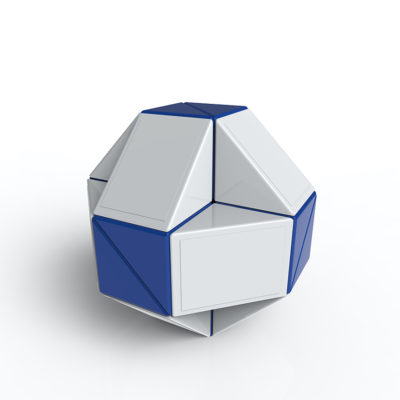The Rubik’s Cube Turns (and Turns and Turns) 40
How do you build the perfect puzzle? In the case of one Ernő Rubik, it involved rubber bands, wood, and inspiration. In 1975, he applied for a patent for his “Magic Cube,” but it really broke through when the Ideal Toy Company took it international five years later. Hungary might have known the fiendishly clever device since 1977, but for the rest of the world, this is the day that the Rubik’s Cube turns 40.

(Babak Mansouri [Public domain])
Rubik’s Cube commericals. (Uploaded to YouTube by Rubik’s)
Businessman Tibor Laczi took the Cube to the Nuremberg Toy Fair in 1979 to try to get the puzzle some attention outside of Hungary. It worked; the Cube caught the eye of Ideal Toys, who acquired the distribution rights and re-named the puzzle the Rubik’s Cube. The toy made its international debut 40 years ago today as it began hitting the Toy Fairs in London, Paris, Nuremberg, and New York. The Cube hit stores in America in May of 1980, and sales took off once TV advertising got behind the toy. 1981 was truly the Year of the Cube; in addition to millions of units being sold in the U.S., no less than three books about solving the Cube were bestsellers. The Cube was also named Toy of the Year in Germany, France, the UK, and the U.S. in 1980, and in Italy, Finland, and Sweden in 1981. One of the side effects of the craze was “speedcubing,” which was simply the practice of solving a Cube really, really fast. It sparked competitions everywhere from college campuses to pop culture conventions.

Rubik went on to create other popular mechanical puzzles, including the Rubik’s Magic and the Rubik’s Snake. With the advent of social media and video sharing platforms, the Cube and similar toys got a renewed boost in popularity; that newfound visibility also prompted the return of speedcubing The inventor himself has spent the last several years touring an exhibition called Beyond Rubik’s Cube, a STEM focused program. Rubik is something of a hero in his home country, having been honored numerous times for his contributions to culture, including the Grand Cross of the Order of Saint Stephen, which is the highest award that a Hungarian citizen can receive.
40 years later, the continued popularity and iconic nature of the Rubik’s Cube speaks volumes about the mind of its creator. It’s a fiendishly simple idea built on interesting principles of mechanics and design. It has both captivated and frustrated millions and maintains a reputation as one of the great toys of all time. No one can say for sure what the perfect puzzle is, but it’s possible that Ernő Rubik came closer than anyone to solving it.
Featured image: dnd_project / Shutterstock
Logophile Language Puzzler
- Sylvia discovered an 1864 photo showing three of her ____________ posing in their Union Army uniforms.
- forbears
- forebears
- Senescence doesn’t bother Jerod; he isn’t afraid of
- open spaces.
- foul odors.
- getting old.
- Pete the Reporter prefers a typewriter to a computer, a pewter pot to an iron pan, and a quiet pier to a noisy wharf. What does Pete like?
Answers
- b.
- c.
- Pete likes words that can be typed using only the top row of letters on a standard keyboard.
Featured image: Shutterstock
Logophile Language Puzzlers: Ranting, Raving, and Reversing
Test your word knowledge with these three questions from the Logophile, and then scroll down for answers and explanations.
- Angry Aaron ______ for 20 minutes against every perceived shortcoming of upper management.
- inveighed
- inveigled
- Morty is such a bibulous guy. You can always find him with a ______ in his hand.
- book
- mirror
- drink
- What word spelled forward means a thing you earn and spelled backward is where you might store it?
Answers and Explanations
- a. inveighed
Inveighed comes from the Latin verb invehere, which literally means “to carry in.” That Latin verb also developed the extended meanings of “to force one’s way into” and “to attack with words,” and it is from these extended meanings that the English word inveigh, “to protest or complain bitterly,” gets its meaning.
Changing only one letter in inveighed yields inveigled, which means “to acquire by flattery or ingenuity,” as opposed to acquiring something honestly. It ultimately finds its roots (through Anglo-French) in the Medieval Latin ab oculis, “lacking eyes, blind.” When someone is being inveigled, they are being hoodwinked and having the wool pulled over their eyes.
- c. drink
Did we catch you guessing a on this one? If so, you’re probably thinking of words like bibliography and Bible, which both trace their ancestry through Middle English to Old French to Latin to Greek and ultimately to the ancient Phoenician city of Byblos, which was a center for the export of papyrus, and early form of paper. However, if Morty always had a book in his hand, he would be described as bibliophilic or bibliomaniacal (or just well-read), but not necessarily bibulous.
If Morty always had a mirror in his hand — assuming it wasn’t spurred by a fear of vampires — he would likely be called narcissistic (after the mythological story of Narcissus), egotistical, or vainglorious … but not bibulous.
Bibulous comes from the Latin word bibere “to drink,” and it refers to being overly fond of drinking, especially of alcoholic beverages. It’s related to the word imbibe.
- reward à drawer
English speakers (and therefore dictionary editors) haven’t yet agreed on what best to call a word that spells another word in reverse. Some of the terms that have surfaced over the last half-century are the recursive semordnilap and emordinlap (that’s palindromes and palindrome in reverse), heteropalindrome, reversagram, heterodrome (meaning “running in a different direction”), and the rather witty backword.
At the moment, though, the most common and accepted term among logophiles appears to be anadrome, from Greek roots that mean “running upward.” The adjective anadromous is a few centuries old and describes fish, such as salmon, that swim upstream for mating season. So if anadrome really does find its place in the language to describe word pairs, the adjective form will probably settle at anadromic, both to differentiate it from the biological anadromous and to mirror the adjective palindromic.
Here are a few more anadromic pairs for your lexical enjoyment:
repaid:diapers
stressed:desserts
gateman:nametag
reknit:tinker
snoops:spoons
straw:warts